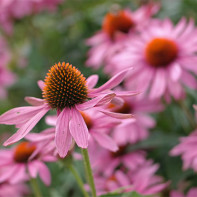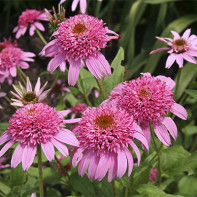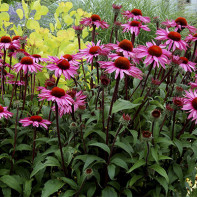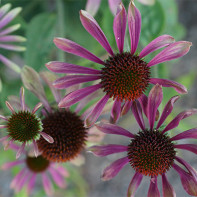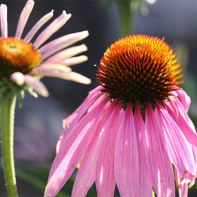Echinacea: medicinal properties and contraindications
Echinacea is a plant native to North America. All species bloom beautifully, so they, like other representatives of the Astrov family, are often grown for decorative purposes. However, echinacea is a natural adaptogen and has many useful properties that are used both in the pharmaceutical industry and in traditional medicine.
- Chemical composition
- How it looks and where it grows
- Kinds
- Collection and storage
- The healing properties of echinacea
- For women
- For men
- During pregnancy
- When breastfeeding
- For kids
- When losing weight
- Echinacea in folk medicine
- With diabetes
- With pancreatitis
- With gastritis
- For the liver
- With cystitis
- With prostatitis
- Against cough
- With a cold
- At a temperature
- With bronchitis
- For immunity
- In oncology
- From papillomas
- Cold sore
- With angina
- With hypertension
- With thrush
- Types of healing compounds
- Infusion
- Tincture
- Decoction
- Tea
- Ointment
- Butter
- Application in cosmetology
- Echinacea Lotion
- Mask for problem skin
- Bath
- Bath for hands
- For dry skin
- For hair
- For dandruff
- What is useful honey from Echinacea
- Contraindications
Chemical composition
Both the aerial part of the plant and the root of Echinacea contain many useful substances that determine its properties.
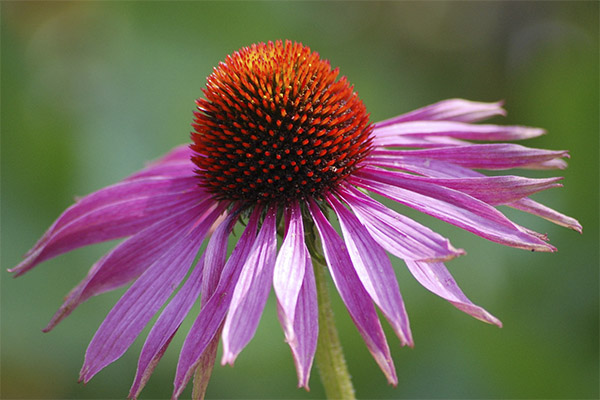
The chemical composition of the aerial parts (stem, leaves, flowers) and rhizomes should be considered separately. Echinacea purpurea herb contains:
- Flavonoids are substances that have anti-inflammatory properties and play an important role in the treatment and prevention of various diseases, including oncology. Echinacea contains rutin and quercetin, which are indispensable in normalizing cardiac activity and improving the state of blood vessels.
- Polysaccharides. They not only act as the main source of energy, but also perform a protective function - protect the walls of organs from mechanical damage and prevent the penetration of viruses into cells.
- Saponins. In pharmacology, they are used as the basis for the production of synthetic hormones. They also have antioxidant properties and weak fungicidal activity.
- Oxycinnamic acids - for example, coffee, which, among other things, has an antiviral effect.
- Phytosterols. These are hormone-like substances that play the same role in the body as human sex hormones.
The composition of the leaves includes some specific antioxidants and glycosides that are present only in echinacea - for example, echinacin, echinological, echinacoside (it is believed that the latter also has antibacterial activity, but this question needs additional research). Also, the grass and stems of the plant contain various organic acids necessary for metabolic processes, tannins and resins.
Echinacea root is also used as a medicinal raw material. It contains:
- Inulin. This is a substance that is not digested by humans, but plays a very important role - in fact, it is dietary fiber, which acts as a prebiotic. They allow you to normalize the intestinal microflora. In addition, inulin helps to establish carbohydrate and lipid metabolism, which is why it is important for people with diabetes. Its root contains up to 6%.
- Glucose is a carbohydrate also needed by the body. In the root of Echinacea it contains up to 7%.
- Essential oils that give the plant a specific aroma.
- Fatty acids necessary for metabolic processes.
- Phenol Carboxylic Acids. In their importance, they are not inferior to flavonoids. In particular, they also have anti-inflammatory properties, but they have an antipyretic and disinfectant effect. Some of them are used as an antirheumatic drug, and they can also eliminate pain in neuralgia.
- Betaine. It is a hepatoprotector, that is, it protects liver cells from various aggressive influences.In cosmetology, its moisturizing properties are used.
Both the leaves of Echinacea and its roots contain many useful enzymes, as well as a number of macro- and microelements, including potassium, zinc, calcium, selenium, etc. There are many amino acids, among which are irreplaceable.
Thus, the main active ingredients are phenolic compounds (caffeic and chlorogenic acids, as well as the above-mentioned echinacoside, which, according to some reports, has antibacterial activity, albeit weak).
How it looks and where it grows
Although the birthplace of Echinacea is North America, today it is grown throughout Eurasia. There are several species, but each is a herbaceous perennial. The average height of the direct stem is 50–100 cm, although there are varieties up to 150 cm high. The rhizome of the plant is pivotal, short, but strong, with numerous lateral roots, rather fleshy.
Rigid lower leaves of the plant are collected in a rosette at the root. They have an oblong shape and a rough surface. Stem leaves are also quite narrow and elongated, with sharp tips, serrated edges, but slightly pubescent. The flowers are collected in apical baskets, the diameter of which is 10-15 cm. The flowers themselves are small, long-lingual. Their color directly depends on the particular variety. For example, in Echinacea purpurea, they are dark red and purple. But there are varieties with pink and even yellow flowers (apparently that is why the latter are often called rudbeckia).
Echinacea blooms from mid-summer to autumn. Then, fruits appear on it (this happens in August-September), which are a tetrahedral achene of a grayish-brown hue.
Kinds
In the wild, there are, according to various estimates, nine or ten species of echinacea. Only some of them are grown in the garden:
- Echinacea narrow-leaved. This is a beautiful plant with a stem up to 100 cm high. At the same time, varieties with both erect and branched stems are found. Quite long and elongated rosette leaves are distinguished by the presence of five clearly visible relief veins on the underside. Stem leaves have a greater length closer to the roots and become shorter at the apex. They also have relief veins on the lower side, but only three. For medical purposes, the roots of this species of echinacea are used (they are dug in the autumn), as well as buds that are collected in mid-summer.
- Echinacea purpurea is a perennial that grows up to 1 m in height. Its roots are shorter and thinner compared to other varieties. The stems have a reddish tint. In most varieties they are bare, but they are also hardy pubescent. The leaves are generally similar to other varieties, but appear more rigid and rough, in addition, they are larger - up to 20 cm in length. Baskets reach a length of 12 cm. Their midpoints are very dark, long reed flowers have a purple hue. This variety blooms in September. In medicine, its inflorescences, and roots, and grass are used.
- Echinacea pallid in the wild is found only in America. In Russian conditions, it is also grown in gardens, for example, on alpine hills and in rockeries, because it loves rocky soils. This is a higher variety, it reaches 120 cm in height, its stems are straight, although there are also slightly branched ones. The name itself indicates that her flowers are not as bright as the rest of the species. They are distinguished by a beautiful pink hue, due to which pale echinacea is grown not only as a medicinal, but also as an ornamental plant, especially since it looks very good in bouquets and stands cut for a long time.
- Echinacea is paradoxical in appearance very similar to rudbeckia, since it differs from other varieties in the yellow color of the petals with a dark brown receptacle. At the same time, the tabs of the flowers seem to be bent down, which makes the baskets visually smaller, although in general their diameter is as large as that of other species.Only in paradoxical Echinacea is such a shape and shade of flowers observed that makes it unique.
- Echinacea of Tennessee. This is a relatively undersized species that rarely grows above 75 cm in height. It features dark green leaves with a lanceolate shape. In addition, compared to other varieties, it has a relatively small number of flowers in a basket. Moreover, all of them are almost at the same distance from each other, which is why from afar the flowering plant resembles a dark sun with pink long rays.
In medicine, only three types of echinacea are used - narrow-leaved, pale and purple, the latter most often. But in the rhizome of Echinacea pale and narrow-leaved contains a unique component - phytomelanin, which is an antioxidant and has the properties of a cytoprotector (that is, it protects the cells of the body from aggressive influences). In the future, unless otherwise specified, we will talk about echinacea purpurea.
Collection and storage
Echinacea purpurea is not a pharmacopeia plant in Russia and Ukraine. Therefore, strict standards for the quality of medicinal raw materials are not presented, except for its environmental friendliness. You can collect it yourself, if you grow echinacea in your area.
The collection of flower baskets for pharmaceutical purposes is carried out during the flowering period, that is, starting in mid-July. Rhizomes can be excavated only not earlier than October.
Stems should be cut to a height of 25–35 cm. It is recommended to collect leaves, stems, and flowers early in the morning. Then the raw materials to sort, cut and dry - best in a ventilated dark room, but it is also possible under a canopy. The main thing is that the sun's rays do not reach it, under the influence of which beneficial substances are destroyed. Rinse the rhizomes, dry, sort through again, and then cut and dry in the sun. You can also use dryers for vegetables, but only in a gentle mode, at a temperature of 40-60 degrees.
Like other plant materials, grass, flowers, and roots should be stored in linen bags or paper bags, only in a dry place well protected from sunlight.
Sometimes juice is made from fresh herbs and flowers by mixing it with an alcohol base and stored in the refrigerator for no more than two months. This juice has a high concentration of active substances, it is used mainly for accelerated wound healing.
The healing properties of echinacea
Currently, scientists continue to study the properties of echinacea, since it is considered a very promising plant. In particular, it has the following properties:
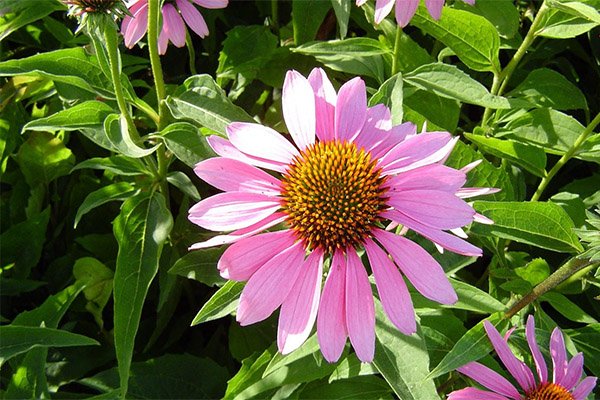
- It enhances natural immunity, because it activates phagocytes (the so-called protective cells of the immune system itself).
- It has anti-inflammatory and antioxidant effects.
- Promotes the rapid healing of burns, ulcers, various wounds.
- It has a weak antiviral and antibacterial effect, which allows it to be used in the complex treatment of infectious diseases, with furunculosis, for the treatment of carbuncle, abscesses, etc.
- It has a membrane stabilizing effect.
- Effective in the treatment of autoimmune diseases (for example, rheumatoid arthritis, some types of hepatitis).
In addition, the composition of echinacea includes such a component as cis-1,8-pentadecadiene. It is believed that it has antitumor properties, but they have not yet been fully studied. In the future, echinacea can also be used to treat cancer.
For women
The aerial part of Echinacea contains phytosterols, which allows you to normalize hormonal balance, restore the menstrual cycle, get rid of the painful PMS, and significantly alleviate the condition during menopause. In this case, phytosterols act in the same way as natural hormones, without the side effects inherent in synthetic drugs from this category.
In addition, Echinacea preparations have proven themselves in the treatment of inflammatory gynecological diseases.
For men
For the stronger sex, Echinacea preparations are interesting for two reasons. Firstly, this is the beneficial effect of the plant’s active substances on the cardiovascular system. After all, it is men who most often suffer from circulatory disorders and pathologies of cardiac activity. Secondly, these are anti-inflammatory properties that allow the use of echinacea to treat prostatitis.
During pregnancy
The above components make echinacea a tonic. Therefore, preparations based on this plant are contraindicated for expectant mothers, so as not to provoke a miscarriage or premature birth.
When breastfeeding
During lactation in the first two months, young mothers should not take any herbal preparations so as not to provoke an allergy. In the future, echinacea can be taken only as prescribed by the doctor, since it will have an exciting effect on the child.
For kids
It is believed that for children under two years of age, echinacea is generally contraindicated, since there is a very high risk of developing allergic reactions. However, in the future, preschool children and primary school children are given echinacea as an adaptogen on a par with eleutherococcus. However, to begin with, you need to make sure that the child does not have an allergic reaction to her, so for starters give her a small amount and make sure that there is no rash.
Tea with echinacea or a small amount of infusion will help students concentrate better. It also helps to strengthen the immune system, gives energy and even improves memory.
When losing weight
The substances that make up Echinacea contribute to the improvement of carbohydrate and lipid metabolism - these are inulin, caffeic acid, and some other components. Echinacea alone will not help to lose extra pounds, but it will increase the effectiveness of other activities - the main diet and sports. Echinacea-based tea will improve metabolism and remove harmful substances. In addition, fresh grass and Echinacea leaves can be used as a dietary supplement. For example, they make vegetable salads, mixing with other useful ingredients like chicory.
Echinacea in folk medicine
In folk medicine, both water and alcohol infusions from this plant are widely used, as well as oil tincture, ointment, tea, various fees, etc. Each of these tools has its own scope, but most often it is treated with alcohol tincture. It has the widest spectrum of action, including gastritis and other inflammatory pathologies of the digestive tract, constipation, and inflammation of the pelvic organs. It is also effective for bronchitis, tonsillitis, herpes, is used even in the complex treatment of pneumonia (but only along with antibiotics and other official medicine, including with prescribed drugs to expand the bronchi).
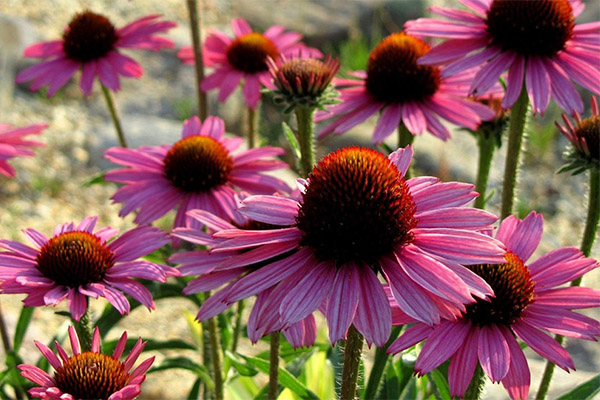
Water or oil infusion are considered good remedies for autoimmune diseases, rheumatism, arthritis, joint pathologies. They work better for colds, regardless of whether they were triggered by bacterial or viral infections. Water infusion can also be used for a long time to strengthen immunity.
Ready-made alcohol tincture from the root is used to treat kidney diseases, including stone removal. It also helps with spasm of blood vessels. And some experts consider it a good remedy for asthma.
In its raw form, the plant is used to treat burns and wounds. Also in this case, decoctions are effective, with which lotions and compresses are made.
With diabetes
There is no consensus on the use of echinacea in the treatment of diabetes. Some herbalists believe that remedies based on this plant are generally contraindicated in diabetes. Others believe that tincture of echinacea in this disease will be beneficial, but it should be used with caution. It is best for this to take the root tincture for alcohol - 60 drops per day, divided into 3 doses.Honey with echinacea is not used for this disease.
With pancreatitis
In acute pancreatitis, it is impossible to be treated with home remedies, you need to immediately seek qualified medical help. But in the chronic form of the disease, alcohol tincture of echinacea will help relieve inflammation of the pancreas. To do this, on the first day they drink immediately 40 drops of tincture diluted with a small amount of water, then reduce the dosage to 20 drops - three times a day for half an hour before meals. The course of treatment is no more than 10 days, because otherwise blood pressure can increase significantly.
With gastritis
This disease means the presence of an inflammatory process on the gastric mucosa. In the period of exacerbation, echinacea is not used. During remission, patients are given an alcoholic infusion of the flowers and leaves of the plant, prepared according to the recipe below. However, some herbalists believe that oil extract in such cases will be even more effective.
Take no more than 20 drops 3 times a day. In the same dosage, the drug is used for diseases such as stomach and intestinal ulcers, colitis, etc. During the year, the course can be repeated several times, but only after consulting a doctor and in the absence of diseases like hypertension.
For the liver
In general, to improve liver health, they either drink tea (1 cup per day, divided into three doses), or take echinacea tincture not in alcohol, but in vegetable oil. It is prepared in a proportion of 1 part plant material to 5 parts unrefined sunflower or olive oil. Drink tincture 10 ml three times a day 2 hours after the main meals.
With cystitis
This inflammatory process is usually caused by a bacterial infection. To eliminate it, antibiotics are used. Echinacea is also used as an adjuvant due to its anti-inflammatory properties. To do this, prepare an aqueous infusion of its flowers. Do it like this - take a handful of dried raw materials and pour 1 liter of boiling water. It is best to insist this remedy in a thermos - it will maintain the temperature for 8 hours. Before use, the product is filtered. Take it throughout the day in small portions, a maximum of 100 ml. The course of treatment is 4–5 days, after which the inflammation usually goes away, but if necessary, it can be repeated after a while.
With prostatitis
With this disease, alcohol tincture of Echinacea root is used, most often ready - 20-30 drops three times a day before meals. The course of treatment lasts 10 days, then take a break. Also, some doctors prescribe ready-made tablets containing echinacea.
Against cough
In folk medicine, in the treatment of cough, rubbing with alcohol tincture in the lung area is considered a good remedy.
With a cold
With colds and SARS, an infusion of echinacea is considered an effective remedy. It is taken ½ cup three times a day, half an hour before the main meals. They drink the drug with a minimum duration of 10 days.
At a temperature
Echinacea itself does not have a strong antipyretic effect. It is used in the treatment of infectious diseases accompanied by high fever. To do this, take the infusion as described above for the common cold.
With bronchitis
The application will be the same as for any disease accompanied by a cough - rubbing with alcohol tincture.
For immunity
For these purposes, they drink either tea prepared according to the recipe described below (1 cup per day) or alcohol tincture (20 drops three times a day).
In oncology
The effectiveness of echinacea in cancer has not been proven. But some herbalists recommend taking alcohol tincture of its root - 20 drops three times a day, diluting with a small amount of water.
From papillomas
Echinacea will not help remove the papilloma - this can be done only with the help of celandine juice (or even better, contact a dermatologist for this and remove the growth in the clinic). But echinacea helps fight the cause of papillomas, that is, the HPV virus.The fact is that he often lives in the body for many years, without showing up at all, but activates with a decrease in immunity, while echinacea helps strengthen the immune system.
To do this, take 15-20 drops of echinacea tincture three times a day. The course of treatment is 10 days, then they take a break for 5 days and repeat the dose.
Cold sore
This disease is viral in nature, therefore, in its treatment, echinacea is mainly used as an adjuvant, which helps to heal wounds and cracks. In such cases, alcohol tincture of Echinacea root is considered the best option. It disinfects wounds and cracks, and relieves pain, and eliminates the symptoms of inflammation.
At home, tincture is prepared as follows - take fresh plant roots (200 g) and pour 1 liter of vodka or 40% alcohol solution. This tool is insisted for 14 days, leaving in a dark and dry place. Periodically shake the container with it. Before use, tincture is filtered and diluted 1: 3 for the treatment of herpes. At the same time, it is used as an external agent - lotions are made from it on the affected areas of the skin.
With angina
In the treatment of tonsillitis, the anti-inflammatory properties of echinacea are used. In this case, both a decoction of Echinacea and its tincture are used. Drink tincture the same way as with any other inflammatory disease - 40 drops in the first dose, then reduce the dosage to 20-25 drops (in the period of exacerbation, drink every two hours, then the number of doses decreases).
As for the broth, then for oral administration it is prepared as follows - 1 tbsp. teaspoon of dry crushed raw materials per 0.5 l of boiling water. This tool is placed in a water bath for 20-30 minutes. Then the broth is cooled, filtered and drunk a little during the day.
It can also be used to rinse the sore throat. The procedure is repeated every two hours. The broth is prepared as described above, take 1 tbsp. spoon, diluted with the same amount of warm water and gargle. You can buy packaged dry echinacea at the pharmacy. In this case, brew for rinsing like tea - one bag per glass of boiling water.
With hypertension
Echinacea purpurea is most often used with low blood pressure, as it helps bring it back to normal. Therefore, with hypertension, remedies based on the roots, leaves and stems of this plant are contraindicated.
However, in folk medicine, Echinacea flowers are also used for high blood pressure. To do this, take 100 g of dried flowers, crushed to a powder and mixed with 300 g of honey. This remedy is used for hypertension with literally 1 teaspoon per day, adding it to herbal tea.
With thrush
This disease is fungal in nature. The reason for its development is a decrease in immunity, due to which conditionally pathogenic microflora (Candida fungi) begins to multiply actively. Echinacea tincture, of course, does not have antifungal properties, but is used as an adjuvant in complex therapy.
First of all, it helps to eliminate inflammatory processes. To do this, in the first dose they drink 40 drops of alcohol tincture (ready or home made according to the recipe below), then 20 drops three times a day. The course of treatment is 10 days. After that, take a break for a week. If necessary, you can repeat the course. Tincture diluted with a small amount of water.
Another method of application is in a solution with which vaginal tampons are impregnated (not more than 20 drops). An aqueous solution of tincture is also used for gynecological baths.
Tincture of Echinacea also helps to increase immunity, eliminating the very cause of thrush. To prevent candidiasis, it is taken 15 drops twice a day, adding to green or herbal tea. The course - as in the treatment of acute illness, 10 days, then a break. You can also drink Echinacea tea for prevention.
Types of healing compounds
On the basis of Echinacea make infusion, decoction, alcohol tincture, tea, various products for external use. And each of them has its own characteristics of preparation and use.
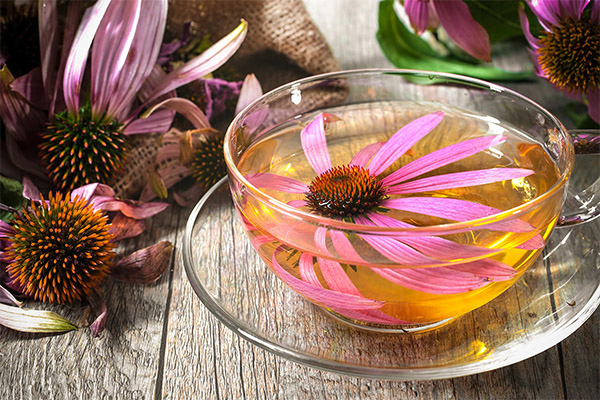
Infusion
It is believed that water infusion of echinacea improves blood composition, accelerates regenerative processes - for example, wound healing, tissue repair after bruises and fractures. The infusion can also be used as an external remedy - it is used in the form of compresses or lotions against eczema, psoriasis and even boils. It promotes tissue repair after burns.
Prepare it like that. Take 1 tbsp. a spoonful of dry chopped Echinacea grass (the flowers of the plant can also be used as a raw material, in addition to leaves and stems) and pour 2 cups of boiling water, and then left overnight in a thermos or in an enamel container, wrapped with a towel on top so that the product cools down more slowly. It is filtered before use.
Tincture
Echinacea alcohol tincture is taken as an anti-stress agent. It also improves cognitive function. Echinacea helps to concentrate better, it also improves performance.
Tinctures are of two types - based on the aerial parts of the plant or root. As shown above, such raw materials differ in chemical composition. At home, they often make tincture of leaves and herbs. Take either 200 g of crushed fresh raw materials, or 50 g of dry per 1 liter of vodka. Insist the product in a dark place, shaking from time to time, for three weeks. Filter before use. Root-based tincture is most often done in factory conditions.
Decoction
This dosage form is most often used to enhance immunity. It is also taken as a tonic. It relieves stress and promotes concentration. It is prepared as follows - dried leaves, grass and Echinacea flowers are ground, 1 teaspoon of raw material is taken and a glass of boiling water is poured, and then it is heated over low heat in a water bath for 15–20 minutes. After this, the remedy is insisted for another half an hour. Drink no more than 1/3 cup 3 times a day, before main meals.
Tea
It is believed that this tool helps to avoid colds, and can also be used in the treatment of eczema. They cook it like this - take 2 teaspoons of dried chopped root or the same amount of Echinacea herb and pour 2 cups of boiling water, and then brew for 40 minutes. Before use, you need to strain.
Some herbalists use flowers for this purpose - 3 dried flowers for the same amount of boiling water.
For preventive purposes, drink one cup of such tea per day. To improve the taste, honey is added to the drink. The duration of treatment is at least a month. If a person feels that he is getting sick, you can take 3 cups of tea a day at the beginning of a cold, so that it proceeds in a milder form.
Ointment
To heal burns and wounds, a homemade ointment is made using any oily base mixed with freshly crushed fresh flowers and leaves of echinacea. You can also in a small amount add the finished tincture of the plant to the purchased medicinal creams and ointments.
Butter
This tool is used mainly in cosmetology, but sometimes in the treatment of peptic ulcer. In fact, this is an oil tincture of echinacea. To prepare it, take 2 parts of fresh flowers and place in a glass container, and then pour unrefined vegetable oil (5 parts). The product is kept for 3 weeks in a dark place. The finished tincture is filtered.
Application in cosmetology
Echinacea purpurea is widely used in cosmetology for skin care for hands and face. There are several popular recipes.
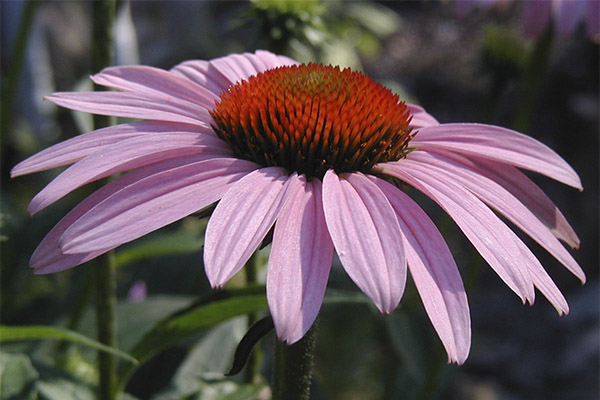
Echinacea Lotion
It relieves irritation, has a calming effect, in addition, it accelerates metabolic processes. It is prepared like this - 25 g of dry raw materials (roots and leaves of Echinacea) are crushed and mixed with a dry string and flowers of a chamomile pharmacy - these components are taken 20 g each. All this is poured with 250 ml of alcohol solution or vodka. The lotion is kept in a dark and dry place for two weeks, then filtered. This product is recommended to wipe the face after washing. Alcohol dries a little, so the tool is perfect for oily skin.
Mask for problem skin
1 houra spoonful of flower honey is mixed with the same amount of alcohol tincture from Echinacea root and add 1 tbsp. a spoonful of rye flour. The resulting mass is applied to cleansed skin for 10 minutes, then washed off with cool water and wiped with lotion.
Bath
This tool helps to improve the condition of the skin of the body, has an antibacterial agent, relieves irritation, etc. Prepare as follows - 5–6 teaspoons of chopped dried flowers and leaves pour 1 liter of boiling water and insist for an hour. Then the tool is filtered and added to the bath. The duration of the procedure is no more than 15 minutes.
Bath for hands
Take 2 tbsp. tablespoons of Echinacea leaves, pour 1 liter of boiling water and insist for 1 hour. Then, the obtained product is diluted with water to 2.5 l, 100 g of sea salt are added to the infusion, and hands are immersed in the resulting bath for 20 minutes.
For dry skin
Echinacea oil described above is used to care for dry skin. Take the resulting tincture and apply in a small amount on the face with light circular movements. Leave the oil for 3 minutes, then the non-absorbed residues are removed with a napkin.
For hair
Echinacea is also used for hair care. For example, the infusion of this herb, mixed with lemon juice, is used to rinse. It makes hair smoother and more shiny.
For dandruff
To combat seborrhea, such a tool is used - fresh leaves and flowers are crushed to a homogeneous mass, mixed with raw egg yolk, mixed thoroughly and applied to the scalp. Hold the mask for half an hour, then rinse off.
What is useful honey from Echinacea
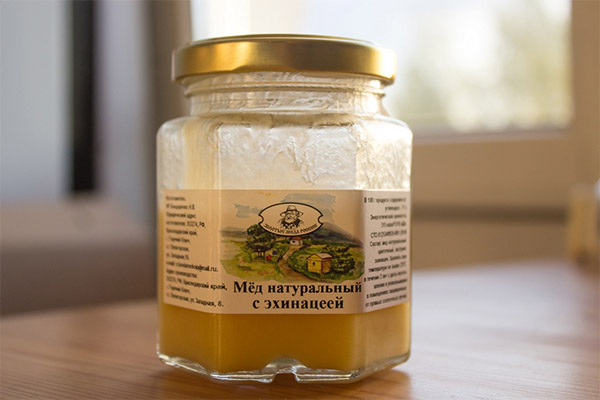
It’s very difficult to meet echinacea honey on the market. The fact is that it is grown in relatively small quantities. But the plant blooms in late summer, when the bees lack food, so many scientists and beekeepers believe that it needs to be cultivated purposefully. Echinacea honey has all the beneficial properties of this plant:
- helps to improve blood composition;
- normalizes the liver;
- struggles with diseases of the respiratory system;
- helps to remove toxins from the body.
In the early 2000s, studies were conducted that showed that the use of such honey had a positive effect on the health status of the liquidators of the Chernobyl accident.
In conditions of deficiency of real honey from echinacea, you can use its natural substitute. Prepare it at home as follows - mix natural floral honey with ground on a coffee grinder to a flour condition with dry leaves and echinacea flowers (in a proportion of 1 teaspoon of plant material for 3 teaspoons of honey). This remedy also has all the beneficial properties of honey and echinacea. It is taken in 1 teaspoon 2-3 times a day, best of all with green tea. It helps to relieve headache, normalize sleep, lower blood pressure. Also, such honey is an excellent remedy for vitamin deficiency.
Contraindications
A contraindication to the use of echinacea is the presence of pulmonary diseases such as sarcoidosis and tuberculosis. You can not take its drugs with multiple sclerosis and leukemia. Absolute contraindications are also pregnancy and the presence of an allergic reaction to this plant. During breastfeeding, the use of echinacea-based products is possible only after consulting a doctor.
Children under two years of age are not prescribed echinacea due to the fact that there is a high risk of developing an allergic reaction. In this case, alcohol tincture should not be given until the age of three.
It should also be noted that echinacea is not combined with all drugs. It is widely used in herbal medicine in collections with wild rose, hawthorn, yarrow, St. John's wort, and some other herbs.But in combination with cardiac drugs, you can not take echinacea, since this can lead to heart rhythm disturbances.
In addition, you can not take echinacea for longer than 10 days without a break in order to avoid the development of such an undesirable side effect as an increase in blood pressure.
«Important: all information on the site is provided exclusively in fact-finding purposes. Before applying any recommendations, consult with a profile specialist. Neither the editors nor the authors are liable for any possible harm caused materials. "

